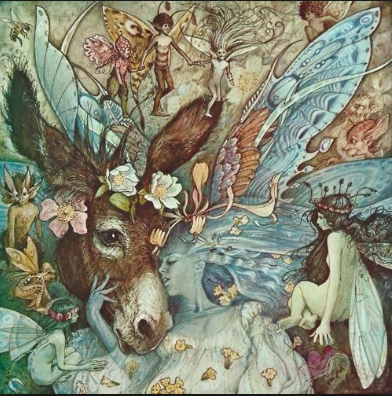By Anna Conkey
 Belief in fairies has changed drastically from early British folklore till now. Much of that change is actually historically attributed to Shakespeare’s work, particularly his play A Midsummer Night’s Dream.
Belief in fairies has changed drastically from early British folklore till now. Much of that change is actually historically attributed to Shakespeare’s work, particularly his play A Midsummer Night’s Dream.
Until his play, the classical belief was that fairies were beautiful, temperamental, and dangerous larger-than-life beings who could grant humans gifts or punishments on a whim (Whitesides). They were associated with beauty, song, dance, cleanliness, and nature. Fairy folklore seems to have originated with the Keltic lands of Scotland, then spread to the British Isles.
The folklore began with commoners as a way to explain why bad things happened. For instance, if a farmer had a bad crop or lost livestock, if a maid spilled the milk, or the cow wasn’t giving any milk, it was attributed to fairies enacting revenge on humans for not leaving them an offering of bread or milk (Whitesides). Sometimes even having an unclean home could be attributed as a reason for “punishment.” This folklore eventually became known to the aristocracy through servants or nurses who would tell the children they were watching about what scary things might happen to them if they did not behave or keep clean. It became a means for good behavior in children—much like today’s idea of the boogeyman:
Our mothers’ maids have so terrified us with an ugly devil having horns on his head, fire in his mouth, and a tail in his breech, eyes like a basin, fangs like a dog, claws like a bear, a skin like a Niger, and a voice roaring like a lion … and they have so fraied us with bull beggars, sprites, witches, urchins, elves, hags, fairies, satyrs, Pans, fauns, sylens, Kit-with-theCanstick, Tritons, centaurs, dwarfs, giants, imps, calcars, conjurors, nymphs, changelings, Incubus, Robin Goodfellow … and other such bugs, that we are afraid of our own shadows. (Scot, 86)
Besides being associated with nature and the seasons, some believed fairies were fallen angels or demons. In fact, the word Puck or Pouke is an old word for Devil (Fairy Mythology). Similar words in different countries for fairies are Puki, Piskey, Pixey, and the more familiar Pixie (Fairy Mythology). Perhaps this is even where the word “pesky” is derived.
Shakespeare was very knowledgeable of the old traditions, and some believe it is because he actually believed them (Whitesides). What is ironic about this is the way he portrayed fairies in his plays actually changed the idea of frightening fairies into our modern view of them as charming, but sometimes mischievous, little sprites.
According to Oberon’s Mazéd World (1977), by T. Herbert, Robin Goodfellow was a name that meant mischief and laughter, Oberon was a spirit of romance, ensuring loving behavior, and Titania’s name suggests “the cosmic forces animating the old Athenian world, the unruly order of the Titans’ children” (33).
From a feministic perspective, fairytales allowed women to challenge dominant ideologies because “the women aligned with fairies … are linked to aberrant behavior but are not subject to damnation” (Buccola, 11). This can be seen in A Midsummer Night’s Dream with Helena pursing Lysander, rather than the other way around, and then successfully ending up with him due to the efforts of the fairies.
It is interesting to note that whether or not Shakespeare believed in the fairies, his Catholic roots supported their existence, so to include them in his plays was a jab at the Protestants who dismissed fairies as Roman paganism (Buccola, 8). Additionally, imagining the fairies without any demonic elements to them was unusual for his time.
Works Cited:
Buccola, Regina. Fairies, fractious women, and the old faith fairy lore in early modern British drama and culture. Selinsgrove: Susquehanna U Press, 2006. Print.
“Fairy Mythology: Ainsel and Puck. The Fairy Mythology: Great Britian: Ainsel and Puck. N.p., n.d. Web. 11 May 2017.
Herbert, T. Walter. Oberon’s Mazéd World. Louisiana: Louisiana State U Press, 1977. Print.
Scot, Reginald. The Discoverie of Witchcraft. Vol. VII. London: Printed by E. Cotes and are to be sold by Thomas Williams, 1654. Print.
Whitesides, Leeann. Overview of the Elizabethan Fairy. Shakespeare and The Fairy. N.p., 08 Dec. 2013. Web. 11 May 2017.